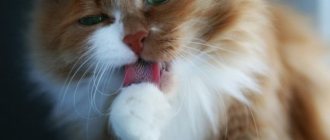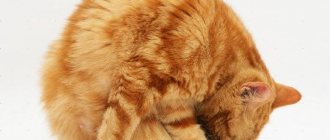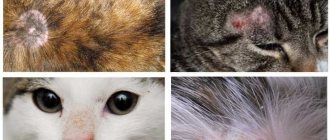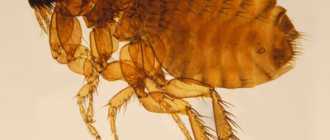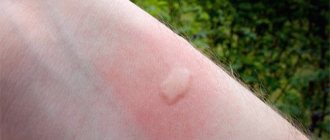If a cat licks its fur right down to its skin, this may be a sign of severe stress and the influence of other external factors. In veterinary medicine, this phenomenon is known as overgrooming.
If owners notice hairless patches on the belly, back, tail, hind legs and other parts of the body, the problem may be lice, fleas or small parasites.
Wounds that a cat scratches to the point of bleeding can lead to serious complications, including sepsis, if owners do not seek treatment for the underlying condition.
Causes
Alopecia, in which inflammation of the skin does not occur, is formed for the following reasons:
- endocrine disorders;
- poor nutrition;
- liver diseases;
- stress.
Endocrine disorders
A characteristic symptom of hormonal alopecia is its symmetry. Hair loss occurs due to dysfunction of the following glands:
- sexual in castrated animals;
- pancreas for diabetes;
- thyroid;
- adrenal glands
Sometimes the cause of disruption of the functioning of the endocrine glands is benign or cancerous tumors. The occurrence of neoplasms is facilitated by the use of contraceptives to interrupt estrus or drugs that interrupt gestation. Treatment consists of eliminating the cause, that is, the underlying disease.
Poor nutrition
Most artificially bred cat breeds are prone to allergies to certain foods. Responsible breeders warn customers purchasing kittens what to feed their pets. The optimal solution is to use factory-made hypoallergenic food. Dry or wet food has the required level of calories, and vitamins, amino acids, and microelements are contained in sufficient quantities at optimal ratios.
The trouble with adherents of natural nutrition is their inability to plan a diet. The energy needs of cats are not taken into account. Excessive caloric intake leads to obesity. Low-calorie diets are prescribed for overweight cats. If there is not enough energy, the sulfur-containing amino acids that make up the hairs, as well as the vitamins involved in metabolism, are not properly absorbed. It is very bad if the indicated components are contained in the food offered to the cat in insufficient quantities.
Adherents of feeding natural products suspect that their pet lacks vitamins and uncontrollably uses feed additives. But an excess of biological catalysts is even worse. With hypervitaminosis, vital substances become toxins. The body tries to get rid of them as quickly as possible - with excrement and low-value body parts - hairs.
Hair is lost quickly and grows back slowly. The veterinarian prescribes medicinal food that accelerates the restoration of the coat. If the cat owner is a conscientious felinologist, he will not allow the disease to occur. The secret is simple - use premium ready-made food.
Liver diseases
The disease occurs as a result of prolonged intoxication of the animal with unhealthy food or an infectious disease. Beggar cats are at risk. Compassionate housewives treat them with delicacies, not suspecting that they are causing irreparable harm to their health.
If a kitten is not vaccinated or is not vaccinated in a timely manner, it is at risk of contracting viral infections. A recovered animal develops complications, including liver disease. In both cases, the pet is prescribed a lifelong diet. The veterinarian prescribes hepatoprotectors. The fur grows back slowly.
Stress
Cats are impressionable creatures. The appearance of a newcomer in the house, moving, a change of environment, expert exhibitions cause confusion. Sudden hair loss is considered one of the symptoms of stress. A prudent felinologist always has a calming drug in his medicine cabinet - Cat Bayun or Stop Stress. Medicines taken prophylactically prevent the occurrence of alopecia in your pet. If baldness has occurred, then medications speed up the process of hair restoration.
Causes and symptoms
Healthy hair in cats is shiny, smooth, with strong hair follicles. With the development of disorders in the body, alopecia may occur. Its areas can be symmetrical, with complete or partial hair loss. Even an inexperienced owner will notice problems with a pet’s fur, since there will be large quantities of it around the apartment. You can try to determine the cause of the appearance of bald patches. With some diseases, cats begin to scratch the affected area. If the violation is more serious, the skin begins to peel off, ulcers and scabs appear on it. Sometimes seals form. The reasons why a cat's belly is going bald can be:
- allergic reaction to food or any of its components;
- prolonged stress state;
- mechanical damage;
- avitaminosis;
- hormonal disorders;
- liver pathologies;
- weakening of hair follicles;
- skin diseases of various types.
Allergy
Allergies appear in response to new foods, vitamins or medications, food additives, insect bites and other irritants. Symptoms: receding hairline, skin may become red or covered with small pimples, scratching. In most cases, symptoms go away if the allergen is removed from the diet.
Avitaminosis
Baldness in a pet can be caused by a lack of vitamins A, C and B or minerals. Alopecia areata is characteristic, when areas without hair have a round shape. They form extensive foci, merging together. The skin is bright pink.
Stress
Factors that caused stress could be moving, a new family member (child, another animal). At the same time, the cat begins to rapidly go bald, which is associated with severe shock and stress. When under stress, a cat usually tears its hairs on its own. Susceptible breeds: Siamese, Himalayan, Abyssinian. Their restored hair will be darker in color.
Hormonal disorders
If a cat's belly goes bald, it is often a sign of endocrine pathologies. They can be caused, for example, by neoplasms in any organ. Hormonal imbalance due to castration or sterilization can affect the thickness of the coat.
Skin diseases
Bald areas will be symmetrical. Their location is noted on the torso, limbs, sides and abdomen. Alopecia can occur at any age, and in this case it does not depend on gender. If the damage to the skin is caused by a fungus, it will become dry, with the formation of a rash and peeling. With trichophytosis or microsporia, areas without hair will have redness, scabs, scales and even wounds.
Why is overgrooming dangerous for cats?
Intense, frequent grooming can have serious consequences for a cat's health.
Main signs of overgrooming:
- baldness, hairless areas, bald spots on the body;
- the presence of areas with sparse, brittle hairs;
- deterioration of coat condition;
- allergic manifestations;
- the presence of scratches, ulcers, long-healing wounds on the body;
- lethargy, apathy, or vice versa, constant anxiety.
Frequent licking can damage any areas of the dermis that the cat reaches with its tongue. Most often, damage is noticeable on the abdomen, the inside of the hind legs, on the front legs, sides, and sternum. The lesions are located symmetrically on the body.
By intensively licking the fur on its hind paw or tail, a cat can injure itself . If an infection enters the wound, it will lead to the development of acute inflammation in the deep structures of the dermis. In severe cases, if the cat gnaws the skin, necrotic lesions may appear in the damaged area.
When licking the fur, fleas and lice eaters enter the body, which carry viruses and bacteria. Overgrooming can cause disruption of the natural process of hair change, deterioration of the protective properties of the coat and dermis, which is especially dangerous for cats who walk along the street.
Possible options
Every cat licks under its tail at least several times a week. This process should not be considered pathological, provided that the animal is regularly treated against fleas and ticks (at least once a month) and undergoes quarterly deworming. If you add accompanying symptoms such as redness in the anus, discharge or the appearance of growths, it is recommended to exclude the following diseases:
- Inflammation of the paraanal glands. It can form after eating bones, due to excess weight, soft food. Prolonged diarrhea can also be a cause. The first signs of inflammation may include fidgeting on the butt, constant licking under the tail, and redness in the anus. The problem can be solved by cleaning (at least once every three months, if there is a predisposition to inflammation). It is performed by a veterinarian in a hospital setting. After cleaning, ointments (proctosedyl) and suppositories (ichthyol or sea buckthorn) are prescribed. A change of food and increased hygiene are also indicated.
- Fleas. They can cause itching in different parts of the body. But most often bites occur on the base of the tail and stomach. Therefore, if a cat licks under its tail, behaves restlessly, tries to chew out fur, or tears itself with its paw until it bleeds, then flea treatment should be carried out. The fact that your pet does not leave the house is not 100% protection against parasites. The owner himself can bring them on clothes or the soles of shoes. Fleas are not dangerous to humans (they do not parasitize the skin), but in some cases they can bite. All animals are treated, regardless of the presence of symptoms. The most effective drugs are Stronghold and Frontline. They are produced in the form of drops, which are evenly applied to the withers so that the animal cannot lick the drug. It is recommended to perform this procedure at least once a month.
- Worms. The most common reason why a cat may lick under its tail frequently. Just like with fleas, an animal does not have to go outside to pick up parasites. He may develop them after being bitten by mosquitoes, mosquitoes, or fleas. Also at risk are pets whose diet contains raw meat and fish. Well, we cannot exclude the possibility that parasite eggs may enter the apartment on the soles of the shoes of the owner or his guests. The first signs of worms are itching in the anus, due to which the cat can ride on its butt on the floor. Licking and gnawing of fur in this area also indicate discomfort caused by parasites. Diarrhea, vomiting and increased appetite (or, conversely, complete refusal to eat) can be considered concomitant symptoms of helminthic infestation. Veterinarians recommend starting to worm animals from 3-4 weeks of age. As preparations, you can use tablets, suspensions or drops on the withers. Of the tablets, Drontal and Milbemax are considered the most effective. They can even be given in crushed form, adding to food. Some manufacturers offer meat-flavored tablets, since many pets flatly refuse to undergo deworming.
- Injury. This option cannot be ruled out. A pet can injure the anal area while climbing trees or after playing or fighting with other animals. Even a small scratch can cause significant discomfort. Because of this, a cat can constantly lick under its tail until it becomes bald. In such cases, it is recommended to carry out antiseptic treatment of the affected area until complete healing. And limit the animal's access to the wound using a special medical cap.
- Neoplasm. Unfortunately, this option should also be considered, especially if the animal is over 10 years old, it has been treated for parasites and there are no visible injuries in the anal area. The tumor can irritate the intestines, which explains the pet's restless behavior. The cat constantly licks under its tail, refuses to eat, and suffers from constipation. If necessary, the doctor performs diagnostic laparoscopy, during which cells are taken from the formation for histological examination. Depending on the type (sarcoma, lymphoma) of the tumor, treatment is selected (chemotherapy, surgical excision). Unfortunately, with tumors in the intestine, the prognosis is always cautious, even if the operation is successful and there are no metastases.
The cat licks himself to holes
I inherited a cat from my mother-in-law. The cat itches all the time and licks its entire belly, paws and tail. These places are simply bare-bald. Horror. And this is in summer, spring and autumn. In winter, it grows overgrown and becomes like a normal cat. She has a collar against fleas and other biting *****. We took it to the vet, they said it was due to stress! It is not clear why stress is seasonal then. And what to do with it?
First of all, take off and throw away the collar, my cat is allergic to it, he is also bald in spots. Now for fleas only drops on the withers if necessary.
There is a special injection at the pharmacy for scabies that may help. You say the cat is stressed, you beat it, it means you don’t give attention to the Jews, what?
To another veterinarian. Mine was allergic to food (he licked himself until he got ulcers). They put a pipe on him so he couldn't lick himself. We fed Royal Canin for the wool and it healed within a month.
allergies maybe. Our cat has allergies. Just feed her the wrong thing, and lo and behold, she’s already itching until she’s bald. look, is your skin red?
Check what could be causing it if you are allergic. Is he sniffing paint somewhere? Maybe in the summer he climbs somewhere where mice are poisoned with chemicals? for some reason it is normal in winter. this is strange.
Our cat also becomes a shabby freak in the summer. Because he climbs anywhere, runs after cats, dogs, fights with them. And when autumn comes - such a fluffy little darling.
She has never kittened, does not climb anywhere, she was climbing even before the collar. I think I’ll put on a special collar so that she doesn’t lick herself, and I’ll take her to another veterinarian.
Our cat was combed until he bled from urolithiasis, the veterinarian gave him a drip for a week, and he was also fed a course of special Hills food. itches periodically, but not so often and not so much
Hills is now produced in Russia, hence the quality of the food has deteriorated, veterinarians advise
Source
How to prevent the problem?
To prevent this problem from occurring, it is recommended:
- Treat your four-legged pet for parasites in a timely manner.
- Protect your pet from emotional turmoil. You can't yell at him. There should be no quarrels in the house in which such an animal lives. To prevent the cat from getting nervous when going to the veterinary clinic by car, it is recommended to call a veterinarian at home if possible.
- Regularly show the animal to a veterinarian for preventive examinations.
- Do not delay treatment of diseases detected in your pet.
- Feed your cat only high-quality food that does not contain allergenic components. If possible, the cat's diet, regardless of whether it consists of ready-made food or self-prepared food, should be agreed with a veterinarian.
- Protect your allergic cat from contact with allergens.
- Observe measures to prevent infection of the animal with various ecto- and endoparasites.
- Regularly care for your four-legged pet: wash it if necessary and comb it in a timely manner.
Source
The cat licked all the fur on her paw
BONE ON THE CAT'S PAW
Good evening, Elena! My cat has exactly the same bump, only on his cheek. He will soon be 16 years old. It’s scary to go to the hospital; he’s too old for anesthesia. And it won’t work out, judging by the last visit to the veterinary clinic. Please tell me, do you know what kind of bad lump THIS is?
This is interesting: Demodicosis Method of Infection in Dogs
Hello! Ours also appeared in an “empty” place. It seems like the cat’s lump doesn’t bother him. When you touch it, the cat doesn’t react in any way, which means it’s painless for him. BUT. a bump is a bump, and that’s no longer good. We don’t go to the veterinary clinic, because the last visit there is apparently etched in the cat’s memory for a long time (the visit was 2 years ago and not about this lump!!). He still remembers. Recently we tried to go to the veterinarian, but the cat was scratching and meowing so much that we had to return home. In general, we don’t know what to do. It’s useless to go to the veterinary clinic, call a doctor home (the cat now won’t let strangers near him).. In general, complete confusion. I saw your message, it felt a little better, after all, we’re not the only ones with such a lump. Just find out what kind of lumps these are. Elena, let’s periodically exchange news about this with you.. Maybe someone can tell us what this is like in our cats.
Good afternoon My cat has a tumor on his leg the size of an apple. The veterinarian thought that it was an abscess, they cut it open, took it for histology, and it turned out to be a benign tumor (the muscle tissue was saturated with lymph). Now he strongly recommends cutting off the paw. Maybe there are some other possibilities? I would be very grateful for advice. And I would really like to know how your cat is?
09/06/10 after the operation, without really coming out of anesthesia, the cat passed away. I can already write about this. The fact is that all the doctors interviewed in the city said that the paw should be removed. Until the last day, the doctor said that everything would be fine (well, just without the paw) and promised to look on the spot -
Source
Site news
The most common causes of alopecia
There are many different reasons why a cat can go bald, but the results often look the same.
Therefore, it is important to be able to differentiate the sources of the disease, which will allow for effective treatment. Naturally, a specialist must make a diagnosis and prescribe treatment measures.
Veterinary dermatologists have listed the most common causes of alopecia in cats.
Dermatophytoses (lichen)
Ringworm is the most common cause of baldness. It is caused by the fungus microsporum canis. Bald spots are localized on the cat's head and face. In dermatophytosis, the hair follicles become infected and damaged, causing hair loss in the affected areas.
Depending on the location and intensity, lichen can be:
- local – isolated areas exposed to infection;
- focal – several foci;
- generalized – multiple lesions.
Only a veterinarian can diagnose dermatophytosis, and he will prescribe the appropriate treatment. You should not treat your cat yourself - the disease can become chronic. With proper treatment, complete recovery is guaranteed.
Parasites (fleas, ticks)
When a cat's skin is infected with demodex - skin mites - patches of baldness can also form. Demodicosis is caused by 2 types of pathogens:
- Demodex gatoi. Contagious. A cat can become infected with it on the street or from a sick animal. The affected areas itch, the cat scratches them, and in the places where they scratch, the cat becomes bald. In this case, there is self-induced alopecia.
- Demodex cati. Not contagious. It is an opportunistic agent that lives on the skin of a healthy cat. When immunity decreases and serious diseases (for example, diabetes) occur, the tick becomes more active. On the affected areas of the skin, hair begins to fall out. The cat does not feel itching - this is typical for spontaneous alopecia.
Self-induced partial baldness is caused by fleas. Their bites are sensitive to cats. They scratch, lick, bite itchy places, and thereby damage the coat and skin. It is even possible that ulcers will appear.
Self-induced alopecia can be caused by the following parasitic infections:
- Notoedrosis - accompanied by severe itching, the cat scratches the skin until scabs form. The lesions are localized on the neck and head.
- Otodecosis is caused by ear mites. Scratching on the head, especially around the ears, can cause bald spots.
- Lice eaters - damage the coat. The infection causes the cat to itch and develop bald patches on the affected area.
- The scabies mite is a parasite that eats passages in the upper layers of the skin, causing unbearable itching. The cat scratches itself until it bleeds.
Allergies
Another reason that a cat goes bald is allergies. It can be food and atopic - caused by allergens contained in the air or in the environment.
In the food form, the allergen enters the cat’s body as a result of the owners’ careless attitude to the diet. Some cheap industrial food can cause an allergic reaction in a cat.
In the atopic form, an unhealthy reaction can be caused by cat cosmetics - shampoo or fragrances. Some medications are also dangerous in this regard: ointments, sprays, drops and even flea remedies. Some flowering plants or home air fresheners may cause allergies.
All these factors can cause itchy skin. The consequence will be scratching and hair loss in the cat.
Examination by a veterinarian and diagnosis
The effectiveness of treatment depends on an accurate diagnosis. As mentioned above, you should definitely contact a special clinic. Prescribing medications yourself is very dangerous. From such “treatment” the cat may lose all its fur.
At the veterinary hospital, your pet will be able to undergo the necessary examinations. One of the main tests is a trichogram. Thanks to it, they receive information about the condition of the coat, making the first conclusions about the causes of the disease.
To care for a cat, you need to know what a furminator is for, whether cats need clothes, everything about mating cats, how to choose a comfortable carrier, whether you need to sterilize a cat, how to trim a cat’s claws, how to make toys for a cat with your own hands, how to give birth to a cat how to make a scratching post.
Did you know? Smuggling cats from ancient Egypt was punishable by death.
The cat licks and itches, but there are no fleas
Even if no fleas were visible during a visual inspection of the cat, this does not mean that there are none at all. Very often, small black grains are visible among the fur, very similar to trash - these are nits. And sometimes, small transparent bubbles – lice eggs – are attached to the pet’s hairs.
However, not only fleas can cause a cat to lick and itch. This can also be done by other pathological microorganisms, such as scabies mites. In this case, the pet will have visible skin damage on the ears, ankles and elbows.
Other possible reasons for your pet licking and scratching include:
- Allergies to food, plant pollen, hygiene products, or insect bites (the cat scratches its face, scratches its ears, intensively licks and bites its paws). In this case, the veterinarian will recommend a diet to test for any specific component of the food that is causing adverse effects.
- Fungal and bacterial inflammation. A set of certain fungi and bacteria are found on the skin and mucous membranes of both humans and their pets. Being in a normal state, these microorganisms do not harm. But if the immune system weakens, their number quickly increases, and inflammatory processes begin. Fungal inflammation causes severe itching.
- Otitis is an ear infection that causes itching. A cat with otitis media itches and displays the following signs: it scratches its face, furiously rubs its ears, and shakes its head; swelling and redness of the ears appears, and purulent discharge from the ears.
- Skin diseases (pyodermitis, notoedrosis, demodicosis, etc.) arise as a result of skin pathologies. The rashes that appear on the skin cause severe itching and discomfort. Scabies can also be accompanied by external signs such as baldness.
Prevention of baldness in cats
To ensure that your cat is not bothered by a disease such as baldness, the following preventive measures should be observed:
- feed the animal with balanced food;
- carry out vaccinations and preventive examinations on time;
- take care of your cat's fur;
- avoid stressful situations;
- exclude contact of a healthy animal with sick ones;
- Treat your cat for external parasites every 4-5 months.
Baldness in cats is common; it indicates a serious malfunction in the body. At the first signs of alopecia, show your animal to the veterinarian and begin treatment, do not start the disease, because it is easier to deal with it in the early stages.
Watch the video in which veterinarian Nadezhda will talk about the causes of alopecia in cats (baldness of cats) and treatment methods.
The cat licks its belly: here's why
It often happens to observe strange behavior of your four-legged friend.
Very often we can see a cat licking its belly. If your cat exhibits this attitude from time to time, there is nothing to worry about.
If, on the other hand, the feline licks the belly excessively, even removing all fur, caution must be exercised. But why is my cat exhibiting this behavior?
© shutterstock
There are many reasons for this “extreme” gesture, and they can be divided into two categories:
- psychological states;
- physical conditions.
But let's see below what various physical and psychological ailments can cause a cat to lick its belly.
Treatment
The veterinarian prescribes treatment not that concerns the itching, but that concerns the very cause of the disease. The course of treatment consists of taking medications and includes both local and internal medications. Depending on the cause of the disease, the veterinarian may prescribe antibiotics, antihistamines (to eliminate allergies), and antifungals.
If scabies and redness of the skin are caused by an allergy to food or hygiene products, their use will have to be stopped and the food replaced with another, in general, to get rid of all allergens.
Alopecias that are associated with breed
Genetic predisposition to baldness deserves special attention. As a result of targeted breeding work, felinologists have developed cat breeds whose genes contain this anomaly. Sphinx, Ukrainian Levkoy, bambino, cojona, elf - the fruits of the labors of breeders. So to speak, they have beneficial alopecia.
Persian cats are particularly prone to dermatophytosis. The reason for this is probably their weak immunity. They are also more susceptible to chronic lichen than others. The trouble with this disease is its frequent relapses.
The disease is severe and seriously undermines the Persian’s health. Considering that rich and fluffy hair is the main advantage of the breed, then the tendency to baldness is a serious problem for Persian cats.
How to help your pet
An attentive owner will always notice in time any unwanted changes in the appearance of his pet. A responsible owner should definitely consult a veterinary dermatologist. It must be remembered that only with an accurate diagnosis can adequate treatment be carried out.
Modern veterinary clinics have all the conditions and equipment to carry out diagnostic procedures and issue an error-free medical opinion. The sick cat will be thoroughly examined and the necessary tests will be carried out:
- blood test: general, biochemical;
- a blood test for the presence of immunoglobulins to determine the likelihood of an allergy;
- scraping from the affected area of the skin.
This way, the veterinarian will get a complete picture of your health status and the causes of baldness and prescribe the appropriate treatment.
What you should absolutely not do: if your cat has a bald spot, and the skin in this area is red and inflamed, you should not self-medicate and use various ointments without the recommendation of a veterinarian. You should take the animal to the clinic as soon as possible.
What is overgrooming in cats?
Overgrooming is excessive licking of fur. Signs of this disease are the formation of patches of fur with broken or sparse hair on the animal’s body. In severe cases, these may be areas with a complete absence of hair (baldness). The main cause of this disease is skin problems. Overgrooming is directly related to stressful situations that pets have experienced.
Decorative breed cats are especially susceptible to mental disorders. In order to calm the feeling of anxiety, cats begin to constantly lick themselves.
Veterinarians say that oriental cat breeds are more prone to developing overgrooming.
What parts of the body are at risk?
Almost any area of the skin suffers from this manifestation. Common sites of injury are:
- stomach wounds;
- scratches on the inside of the hind legs;
- front legs;
- the front or back of the body.
Any damage caused by overgrooming is located on both sides of the body. With partial baldness, the broken hairs of the fur will feel prickly and sharp.
Overgrooming also occurs due to flea bites. In this case, you should undergo appropriate tests and provide effective treatment to your pet. Also, quite often an allergic reaction to cheap food leads to the development of this pathology. If you do not stop giving the animal low-quality food in time, the consequences will be disastrous. Overgrooming causes diseases of the lower excretory tract in cats. In this case, the pet must be examined at a veterinary clinic.
Treatment of overgrooming in cats
If behavioral problems develop in cats and any initial signs of illness appear, you should consult your veterinarian. It will be necessary to identify and eliminate the cause that causes stress in the cat.
It is especially important to consult a doctor if your pet regurgitates hairballs and if your pet begins to lick itself to the point of developing bald patches and skin rashes.
Skin pathologies (allergies, flea dermatitis, tick-borne infection, etc.)
Flea dermatitis Dermatological problems in cats are usually accompanied by constant itching of the skin. To calm it down, animals lick themselves. Persistent licking often provokes hair loss in the areas being licked. The following skin diseases can lead to this behavior:
- allergies to food, pollen of flowering plants, household chemicals, cosmetics used by the owner, etc.;
- dermatitis caused by fleas;
- infections caused by ectoparasites, such as ticks and lice-eaters;
- diseases caused by fungi.
Worm infestation can also cause compulsive licking. Parasitic diseases are accompanied by itching in the anus. Trying to calm it down, the animal licks this area, as a result of which, over time, bald spots form around the anus. To eliminate this problem, antiparasitic veterinary drugs are used.
To choose a suitable anthelmintic, you need to find out what type of parasites attacked the cat’s body. This can only be done in a veterinary clinic.
The cat licks itself to wounds and scratches, how to treat it?
Licking is normal in cats. The animal licks itself in order to be clean. This process takes up 30% of his time during the day. But sometimes excessive hygiene can lead to the formation of wounds, scratches, bald patches and rashes. This is a clear sign that the cat has health problems. There are many reasons for this compulsive licking. The main thing is to notice them in time and diagnose the pathology. Every cat by nature tries to keep itself clean. That's why she licks herself daily and often. Using her tongue, she cleanses: fur, paws, tail, genitals and body. A natural process sometimes develops into an obsession. Then the animal licks the fur down to the skin, wounds, and scratches. There are reasons for this phenomenon.
If a cat cleans its tail excessively, after which ichor appears, this signals the occurrence of pathologies.
While licking, your pet regurgitates hairballs - this is a clear sign that the usual hygiene procedure has become too frequent and diligent.
The reasons for this behavior may be:
- food allergies;
- the presence of parasites and itching;
- the presence of constipation in the pet (in case of licking the anus);
- skin damage;
- stressful situations (moving, home renovations and much more);
- cat fleas and nits;
- presence of scabies mite;
- fungal and bacterial inflammation;
- infectious disease, such as otitis media;
- skin pathologies (pyodermitis, notoedrosis, demodicosis).
The animal experiences stress - as a result, it scratches furiously and cleans its fur. This leads to baldness. Having ruled out all possible external factors influencing the cat’s behavior, you need to urgently contact a veterinarian.
Other causes of excessive licking:
- 1. Often, a cat licks itself under its tail, which most often indicates the onset of estrus in cats. In this case, the only way out of the situation is mating. Sedatives, which can be purchased at any pharmacy, will help calm the female.
- 2. After sterilization, the animal may lick itself frequently.
- 3. At the slightest damage to the skin, the cat licks the fur down to the skin. This may be due to an injury at the site of sterilization or a wound that the pet received while walking outside.
The animal's tongue has spines that allow it to effectively clean its fur and skin. After the cat has eaten, it must lick its face and ears. But if the pet did not eat, did not sleep, but licks itself more and more often each time, this indicates that the animal has health problems:
- 1. Nervous tension. The cat cleans its whiskers and nose. His tail begins to twitch. The pupils of the eyes dilate widely.
- 2. Unpleasant smell. If a cat is stroked by a stranger, then she will definitely lick off the unpleasant aroma that remains on her fur.
- 3. Claustrophobia. If he is locked in a confined space, then the manifestation of the disease is inevitable. The cat licks itself, scratches itself until wounds and suppuration appear. The animal must be released immediately.
- 4. Overgrooming. Its signs are compulsive (active) behavior. The cat will be haunted by an obsessive state. She will actively lick herself around the tail or rump.
- 5. Presence of helminthiasis. With a parasitic disease, the cat constantly licks itself. If the animal is attacked by endoparasites, the condition will be accompanied by tingling and, as a result, the formation of wounds. When examining the pet, black spots are found on the body, which indicate an attack of nits.
- 6. The cat’s apathetic state towards what is happening. It will be accompanied not only by licking, but also by constant itching. The owner will not be able to understand the reason for the animal’s stressed state. Correcting this situation is quite simple - you need to provide your pet with peace.
Licking to the point of baldness
The owner of a purring dog may not even realize that constant, almost non-stop licking of fur is a symptom that the pet is in a state of psycho-emotional instability.
As a rule, all owners are accustomed to the fact that cats lick themselves because they have dermatitis or parasites, but it is also possible that the cat is experiencing real emotional torment. This picture can be observed when an animal needs to mate.
In order to normalize the pet’s condition, after which, accordingly, the bad habit of constantly licking the fur will go away, it is enough to give the cat to drink medications that have a sedative spectrum of action. But it should be borne in mind that they must be taken carefully so that they do not cause side symptoms or addiction in the pet.
Possible options
Every cat licks under its tail at least several times a week. This process should not be considered pathological, provided that the animal is regularly treated against fleas and ticks (at least once a month) and undergoes quarterly deworming.
If you add accompanying symptoms such as redness in the anus, discharge or the appearance of growths, it is recommended to exclude the following diseases:
Inflammation of the paraanal glands
It can form after eating bones, due to excess weight, soft food. Prolonged diarrhea can also be a cause.
The first signs of inflammation may include fidgeting on the butt, constant licking under the tail, and redness in the anus. The problem can be solved by cleaning (at least once every three months, if there is a predisposition to inflammation).
It is performed by a veterinarian in a hospital setting. After cleaning, ointments (proctosedyl) and suppositories (ichthyol or sea buckthorn) are prescribed. A change of food and increased hygiene are also indicated.
Fleas
They can cause itching in different parts of the body. But most often bites occur on the base of the tail and stomach. Therefore, if a cat licks under its tail, behaves restlessly, tries to chew out fur, or tears itself with its paw until it bleeds, then flea treatment should be carried out. The fact that your pet does not leave the house is not 100% protection against parasites.
The owner himself can bring them on clothes or the soles of shoes. Fleas are not dangerous to humans (they do not parasitize the skin), but in some cases they can bite. All animals are treated, regardless of the presence of symptoms.
The most effective drugs are Stronghold and Frontline. They are produced in the form of drops, which are evenly applied to the withers so that the animal cannot lick the drug. It is recommended to perform this procedure at least once a month.
Worms
The most common reason why a cat may lick under its tail frequently. Just like with fleas, an animal does not have to go outside to pick up parasites. He may develop them after being bitten by mosquitoes, mosquitoes, or fleas.
Also at risk are pets whose diet contains raw meat and fish. Well, we cannot exclude the possibility that parasite eggs may enter the apartment on the soles of the shoes of the owner or his guests.
The first signs of worms are itching in the anus, due to which the cat can ride on its butt on the floor. Licking and gnawing of fur in this area also indicate discomfort caused by parasites. Diarrhea, vomiting and increased appetite (or, conversely, complete refusal to eat) can be considered concomitant symptoms of helminthic infestation.
Veterinarians recommend starting to worm animals from 3-4 weeks of age. As preparations, you can use tablets, suspensions or drops on the withers. Of the tablets, Drontal and Milbemax are considered the most effective. They can even be given in crushed form, adding to food. Some manufacturers offer meat-flavored tablets, since many pets flatly refuse to undergo deworming.
Injury
This option cannot be ruled out. A pet can injure the anal area while climbing trees or after playing or fighting with other animals. Even a small scratch can cause significant discomfort. Because of this, a cat can constantly lick under its tail until it becomes bald.
In such cases, it is recommended to carry out antiseptic treatment of the affected area until complete healing. And limit the animal's access to the wound using a special medical cap.
Is licking owners dangerous?
If the animal is healthy, then there is no danger for humans in licking it. Moreover, animal psychologists do not advise rejecting your pet at this moment, even if it is unpleasant for you.
Licking serves as a basic means of communication
It is recommended to somehow gently show the pet that this should not be done in the future.
Some even believe that cats sense their owner’s sore spots and heal them with their energy by licking him.
The behavior of pets can be studied over a long period of time. Some lick themselves right down to their bald patches, causing damage to their health. Others may lick people to show their feelings.
We need to fight it. Whereas such a procedure will not bring danger to humans. This is provided that the pet is absolutely healthy.
The ones who suffer the most are:


